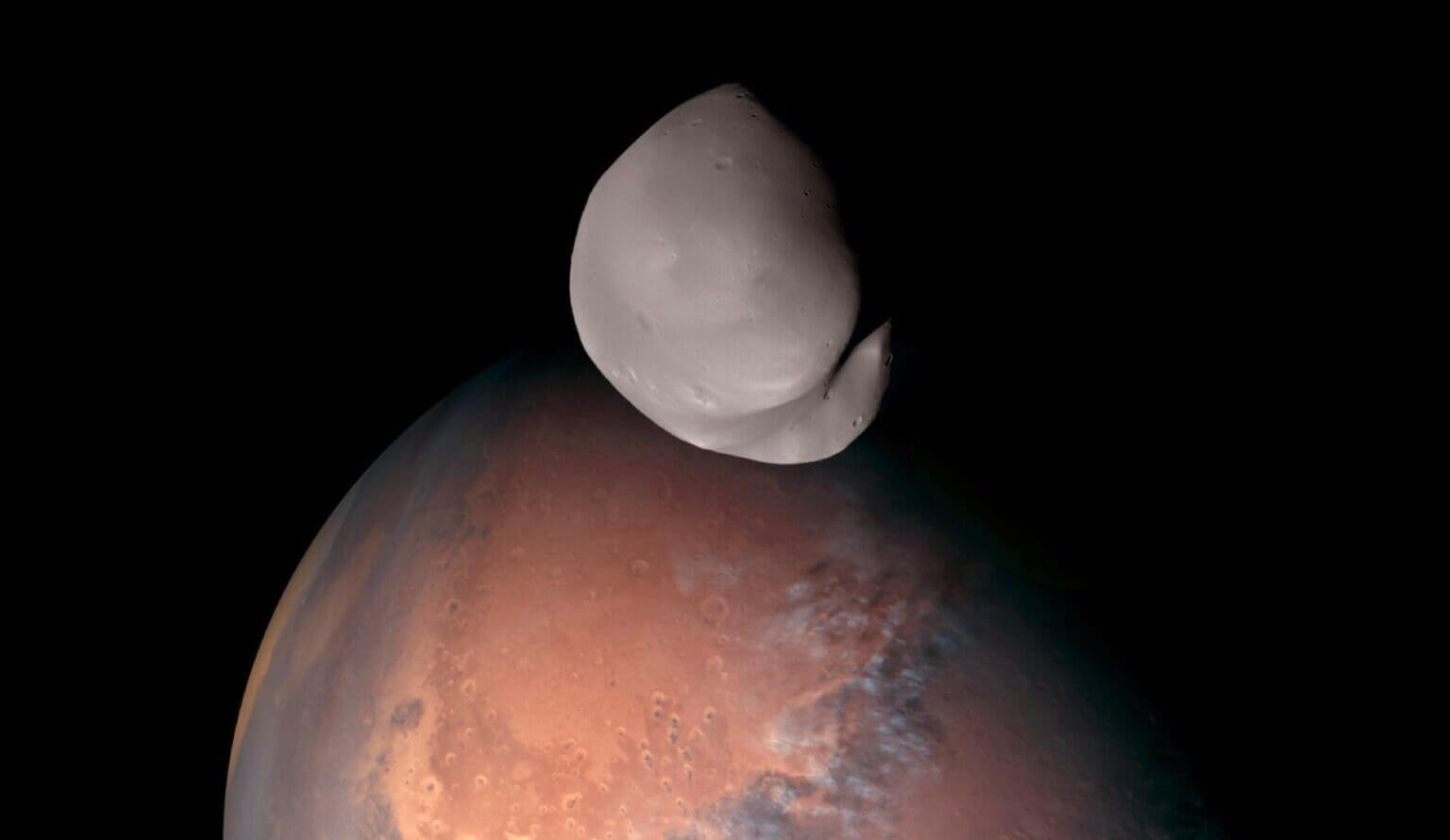Each weekend, an image that made the news or caught our attention. On March 10, the UAE probe Al-Amal provided superb pictures of the planet Mars and its small moon Deimos, reopening an old debate on the origins of the two Martian satellites.
On orbit since February 9th, 2021 around the Red Planet, the Emirati probe Al-Amal (Hope, in Arabic, Hope in English) passed on March 10 at a distance of 104 km from Deimos, the smaller and more distant of the two Martian moons.
The shot obtained on this occasion, with Mars in the background, is one of the most striking that has been made of the star to date.
We asked Gilles Dawidowicz, Vice President of the Société Astronomique de France, to comment on this 221st Space image of the week.
From the time of assumptions
Everyone has known since Kepler, Swift and Voltaire that Mars has two satellites. This assumption was not based on any astronomical observation, but on an idea that the number of natural satellites around a planet, was organized in an ascending order from the Earth.
It turned out to be false, except for Mars, which, as discovered by Asaph Hall (on August 12 1877 from the United States Naval Observatory, near Washington), has indeed two small moons : Phobos and Deimos.
These planetary bodies very quickly appeared to be peculiar. Not only are their peanut shapes reminiscent of asteroids, but their simple orbital parameters immediately arouse astonishment. Also, suppositions about their origin have not stopped for centuries to go well, from the most solid hypotheses, to the most far-fetched ones.
So, it has been proposed that Phobos and Deimos are the result of a co-accretion dating from the formation of the red planet and coming from the " crumbs " that did not constitute the main planetary body of Mars.
The astronomers also suggested that they are small planetary bodies reconstituted following huge collisions between Mars and giant impactors, that they are asteroids captured by Mars, that they are from volcanic ejecta from Olympus Mons, directly satelliteized by the highest volcano in the solar system, or that Phobos is hollow and therefore... artificial !
Rare planetary flybys
Phobos has been the subject of three dedicated space missions (Phobos 1, Phobos 2 and Phobos-Grunt), which were all failures.
Phobos 1 was lost during its Earth-Mars journey, Phobos 2 sent back some images and telemetry data before ceasing all transmission with Earth, and Phobos-Grunt did not go beyond Earth orbit...
As for Deimos, the small planetary body has never been the subject of a dedicated space mission.
However, both moons have been regularly imaged by space probes orbiting Mars.
Thus, Deimos could be photographed for the first time at close range by the Viking 2 orbiter, which approached in 1977 to within 22 km of its surface and obtained shots with a resolution of 1.5 m per pixel.
It was not until 2006 that the incredible Mars Global Surveyor probe and its MOC camera could again photograph the small moon, but this time from nearly 23,000 km away and at the (low) resolution of 95 m per pixel.
In 2009, it was the turn of the Mars Reconnaissance Orbiter probe to photograph Deimos at 20 m per pixel, revealing many previously unidentified details.
Finally, in 2011, the European Mars Express probe approached Deimos to within 9,600 km, and was able to take snapshots with its HRSC camera and measurements with the OMEGA spectrometer.
A complex ID
All of these observations - and many others from Earth or from Mars - have confirmed or clarified a number of astrophysical and geophysical parameters.
For example, Deimos is a small, very low-albedo, irregularly shaped, atmosphere-less body with a size of 15 × 12 × 10.4 km.
It is also a low-mass, low-gravity body that is particularly porous, and its surface is covered by a relatively thick regolith with hues that vary between blackish and reddish, although small bright areas are locally visible and attributed to recent meteorite impacts.
Finally, its nearly circular orbit is weakly inclined with respect to the Martian equator, and Deimos is slowly moving away from the planet.
Then, as for the Moon and for Phobos, Deimos is in synchronous rotation and thus always presents the same face to the planet. Its period of rotation is therefore exactly the same as its period of revolution, i.e. 30 hours and 18 minutes.
What if Al-Amal reshuffled the cards?
Since last January, the Emirati probe has thus been able to fly over Deimos from a distance of about 100 kilometers, and observe in infrared and ultraviolet its surface, including its " hidden " side, its EXI camera providing color and high resolution images in several wavelengths.
According to Christopher Edwards, one of the people in charge of the EMIRS instrument, it already appears that Mars' small moon has " infrared properties closer to the basaltic rocks of Mars than to those of the meteorite that fell near Tagish Lake " in Canada, " often used by analogy to study Phobos and Deimos "
These new observations, and those to come later in the year, should allow us to know more about the true nature of the small planetary body, whose secrets could finally be lifted thanks to Al-Amal, on which planetary scientists are now basing all their hopes...
Découvrez cet article sur Air&Cosmos

